Satas D., Tracton A.A. (ed.). Coatings Technology Handbook
Подождите немного. Документ загружается.

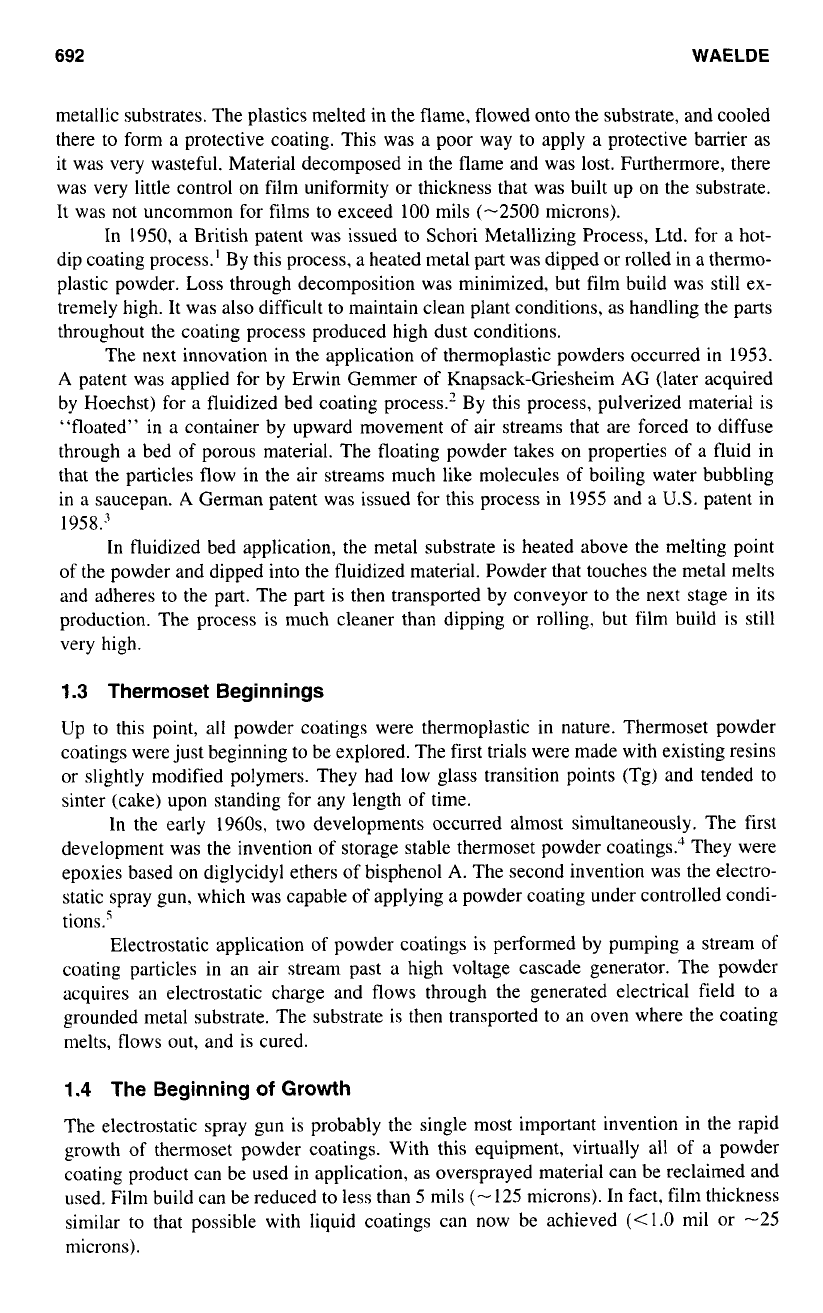
692
WAELDE
metallic substrates. The plastics melted in the flame, flowed onto the substrate, and cooled
there
to
form
a
protective coating. This was a poor way to apply a protective barrier as
it was very wasteful. Material decomposed in the flame and was lost. Furthermore, there
was very little control on film uniformity or thickness that was built up on the substrate.
It was not uncommon for films to exceed
100
mils
(-2500
microns).
In 1950, a British patent was issued to Schori Metallizing Process, Ltd. for a hot-
dip coating process.’ By this process,
a
heated metal part was dipped or rolled in a thermo-
plastic powder.
Loss
through decomposition was minimized, but film build was still ex-
tremely high. It was
also
difficult to maintain clean plant conditions, as handling the parts
throughout the coating process produced high dust conditions.
The next innovation in the application of thermoplastic powders occurred in 1953.
A patent was applied for by Erwin Gemmer of Knapsack-Griesheim AG (later acquired
by Hoechst) for a fluidized bed coating process.’ By this process, pulverized material
is
“floated” in a container by upward movement of air streams that are forced
to
diffuse
through a bed of porous material. The floating powder takes on properties of a fluid in
that the particles flow in the air streams much like molecules of boiling water bubbling
in
a
saucepan. A German patent was issued for this process in 1955 and
a
U.S.
patent in
1958.’
In fluidized bed application, the metal substrate is heated above the melting point
of the powder and dipped into the fluidized material. Powder that touches the metal melts
and adheres to the part. The part is then transported by conveyor to the next stage in its
production. The process is much cleaner than dipping or rolling, but film build is still
very high.
1.3
Thermoset Beginnings
Up
to
this point, all powder coatings were thermoplastic in nature. Thermoset powder
coatings were just beginning to be explored. The first trials were made with existing resins
or slightly modified polymers. They had low glass transition points
(Tg)
and tended to
sinter (cake) upon standing for any length of time.
In the early
1960s,
two developments occurred almost simultaneously. The first
development was the invention of storage stable thermoset powder coatings.J They were
epoxies based on diglycidyl ethers of bisphenol
A.
The second invention was the electro-
static spray gun, which was capable of applying a powder coating under controlled condi-
tions.’
Electrostatic application of powder coatings is performed by pumping a stream of
coating particles in an air stream past a high voltage cascade generator. The powder
acquires an electrostatic charge and flows through the generated electrical field to a
grounded metal substrate. The substrate is then transported to an oven where the coating
melts, flows out, and is cured.
1.4
The Beginning of Growth
The electrostatic spray gun is probably the single most important invention in the rapid
growth
of
thermoset powder coatings. With this equipment, virtually all
of
a powder
coating product can be used in application, as oversprayed material can be reclaimed and
used. Film build can be reduced
to
less than
5
mils
(-
125
microns). In fact, film thickness
similar to that possible with liquid coatings can now be achieved
(<
1
.O
mil or -25
microns).
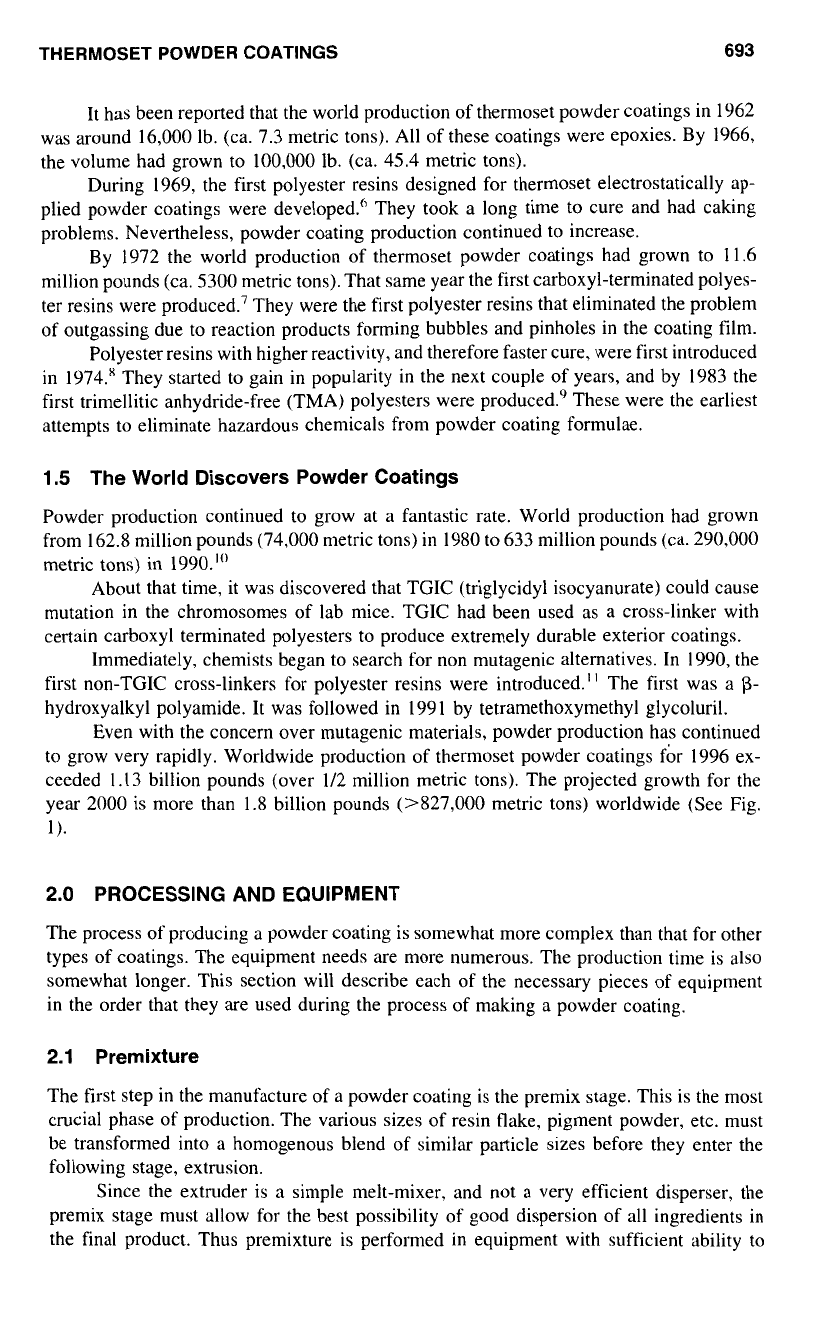
THERMOSET
POWDER
COATINGS
693
It has been reported that the world production of thermoset powder coatings in 1962
was around 16,000 lb. (ca. 7.3 metric tons). All of these coatings were epoxies. By 1966,
the volume had grown to
100,000
lb. (ca.
45.4
metric tons).
During 1969, the first polyester resins designed for thermoset electrostatically ap-
plied powder coatings were developed." They took
a
long time to cure and had caking
problems. Nevertheless, powder coating production continued
to
increase.
By 1972 the world production of thermoset powder coatings had grown to 11.6
million pounds (ca.
5300
metric tons). That same year the first carboxyl-terminated polyes-
ter resins were produced.' They were the first polyester resins that eliminated the problem
of outgassing due to reaction products forming bubbles and pinholes in the coating film.
Polyester resins with higher reactivity, and therefore faster cure, were first introduced
in
1974.'
They started to gain in popularity in the next couple of years, and by 1983 the
first trimellitic anhydride-free (TMA) polyesters were produced.' These were the earliest
attempts to eliminate hazardous chemicals from powder coating formulae.
1.5 The World Discovers Powder Coatings
Powder production continued to grow
at
a
fantastic rate. World production had grown
from 162.8 million pounds (74,000 metric tons) in 1980
to
633 million pounds (ca.
290,000
metric tons) in 1990."'
About that time, it was discovered that TGIC (triglycidyl isocyanurate) could cause
mutation in the chromosomes of lab mice. TGIC had been used
as
a
cross-linker with
certain carboxyl terminated polyesters to produce extremely durable exterior coatings.
Immediately, chemists began to search for non mutagenic alternatives. In 1990, the
first non-TGIC cross-linkers for polyester resins were introduced.'
'
The first was
a
p-
hydroxyalkyl polyamide. It was followed in 1991 by tetramethoxymethyl glycoluril.
Even with the concern over mutagenic materials, powder production has continued
to
grow very rapidly. Worldwide production of thermoset powder coatings for 1996 ex-
ceeded
1.13
billion pounds (over 1/2 million metric tons). The projected growth for the
year 2000 is more than 1.8 billion pounds (>827,000 metric tons) worldwide (See Fig.
1).
2.0 PROCESSING AND EQUIPMENT
The process
of
producing
a
powder coating is somewhat more complex than that for other
types of coatings. The equipment needs are more numerous. The production time is
also
somewhat longer. This section will describe each of the necessary pieces of equipment
in the order that they are used during the process of making
a
powder coating.
2.1 Premixture
The first step in the manufacture
of
a
powder coating is the premix stage. This is the most
crucial phase of production. The various sizes of resin flake, pigment powder, etc. must
be transformed into
a
homogenous blend of similar particle sizes before they enter the
following stage, extrusion.
Since the extruder is
a
simple melt-mixer, and not
a
very efficient disperser, the
premix stage must allow for the best possibility
of
good dispersion of
all
ingredients in
the final product. Thus premixture is performed in equipment with sufficient ability to
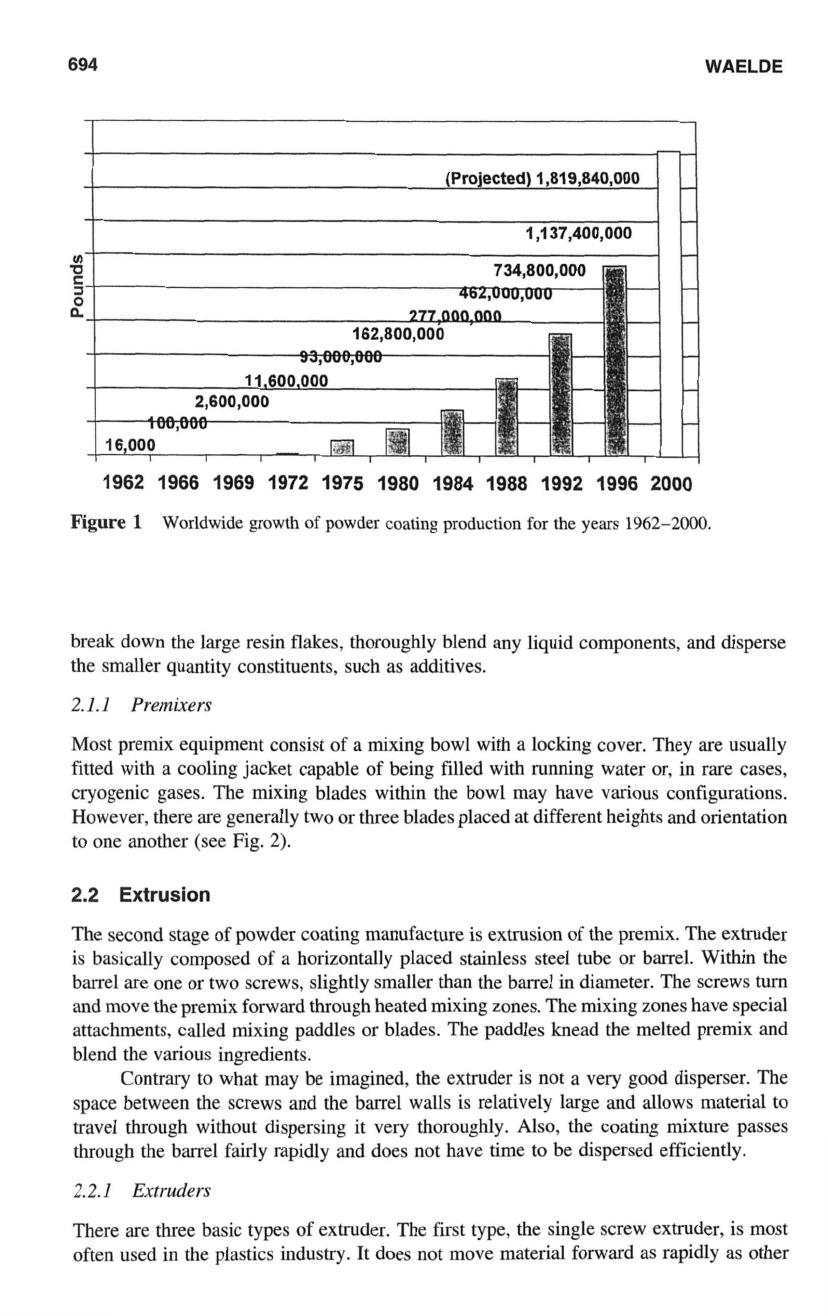
694
WAELDE
~~ ~ ~ ~~ ~~ ~
(Projected)
1,819,840,000
H
U)
U
S
J
0
e
1962 1966 1969 1972 1975 1980 1984 1988 1992 1996
2000
Figure
1
Worldwide growth
of
powder coating production
for
the
years
1962-2000.
break down the large resin flakes, thoroughly blend any liquid components, and disperse
the smaller quantity constituents, such as additives.
2.1.1
Premixers
Most premix equipment consist of a mixing bowl with a locking cover. They are usually
fitted with a cooling jacket capable
of
being filled with running water or, in rare cases,
cryogenic gases. The mixing blades within the bowl may have various configurations.
However, there
are
generally two or three blades placed at different heights and orientation
to one another (see Fig.
2).
2.2
Extrusion
The second stage
of
powder coating manufacture is extrusion of the premix. The extruder
is basically composed of a horizontally placed stainless steel
tube
or barrel. Within the
barrel
are
one or two screws, slightly smaller than the barrel in diameter. The screws
turn
and move the premix forward through heated mixing zones. The mixing zones have special
attachments, called mixing paddles or blades. The paddles knead the melted premix and
blend the various ingredients.
Contrary to what may be imagined, the extruder is not a very good disperser. The
space between the screws and the barrel walls is relatively large and allows material to
travel through without dispersing it very thoroughly. Also, the coating mixture passes
through the barrel fairly rapidly and does not have time to be dispersed efficiently.
2.2.1
Extruders
There are three basic
types
of
extruder. The first
type,
the single screw extruder, is most
often used in the plastics industry. It does not move material forward as rapidly as other
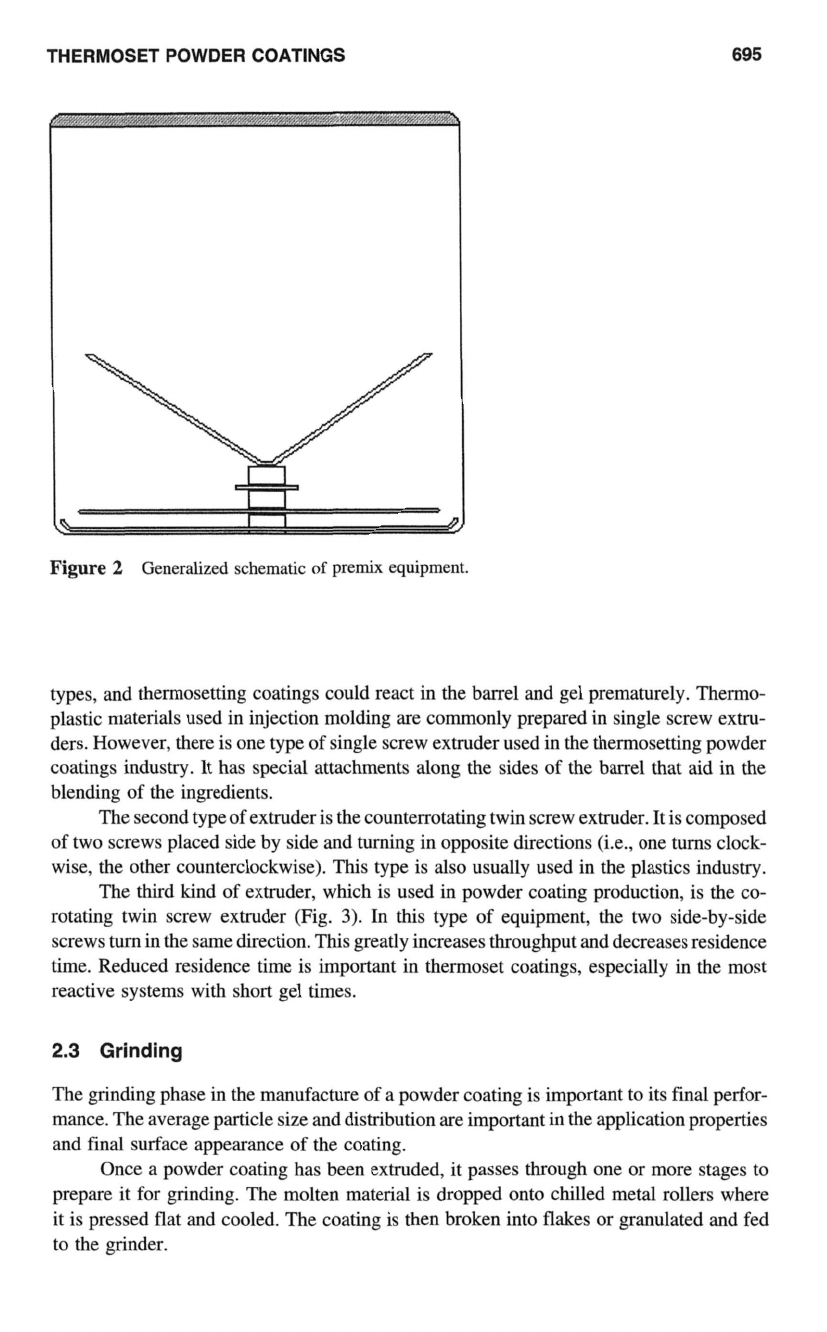
THERMOSET
POWDER
COATINGS
Figure
2
Generalized schematic
of
premix
equipment.
695
types, and thermosetting coatings could react in the barrel and gel prematurely. Thermo-
plastic materials used in injection molding are commonly prepared in single screw extru-
ders. However, there is one
type
of single screw extruder used in the thermosetting powder
coatings industry. It has special attachments along
the
sides
of
the barrel that aid in the
blending of the ingredients.
The second type of extruder is the counterrotating twin screw extruder. It is composed
of
two
screws placed side by side and turning in opposite directions (i.e., one turns clock-
wise, the other counterclockwise). This type is
also
usually used in the plastics industry.
The third kind
of
extruder, which is used in powder coating production, is the co-
rotating twin screw extruder (Fig.
3).
In this type
of
equipment, the two side-by-side
screws turn in the same direction. This greatly increases throughput and decreases residence
time. Reduced residence time is important in thermoset coatings, especially in the most
reactive systems with short gel times.
2.3
Grinding
The grinding phase in the manufacture
of
a powder coating is important to its final perfor-
mance. The average particle size and distribution are important in the application properties
and final surface appearance of the coating.
Once a powder coating has been extruded, it passes through one or more stages to
prepare it for grinding. The molten material is dropped onto chilled metal rollers where
it is pressed flat and cooled. The coating is then broken into flakes or granulated and fed
to the grinder.
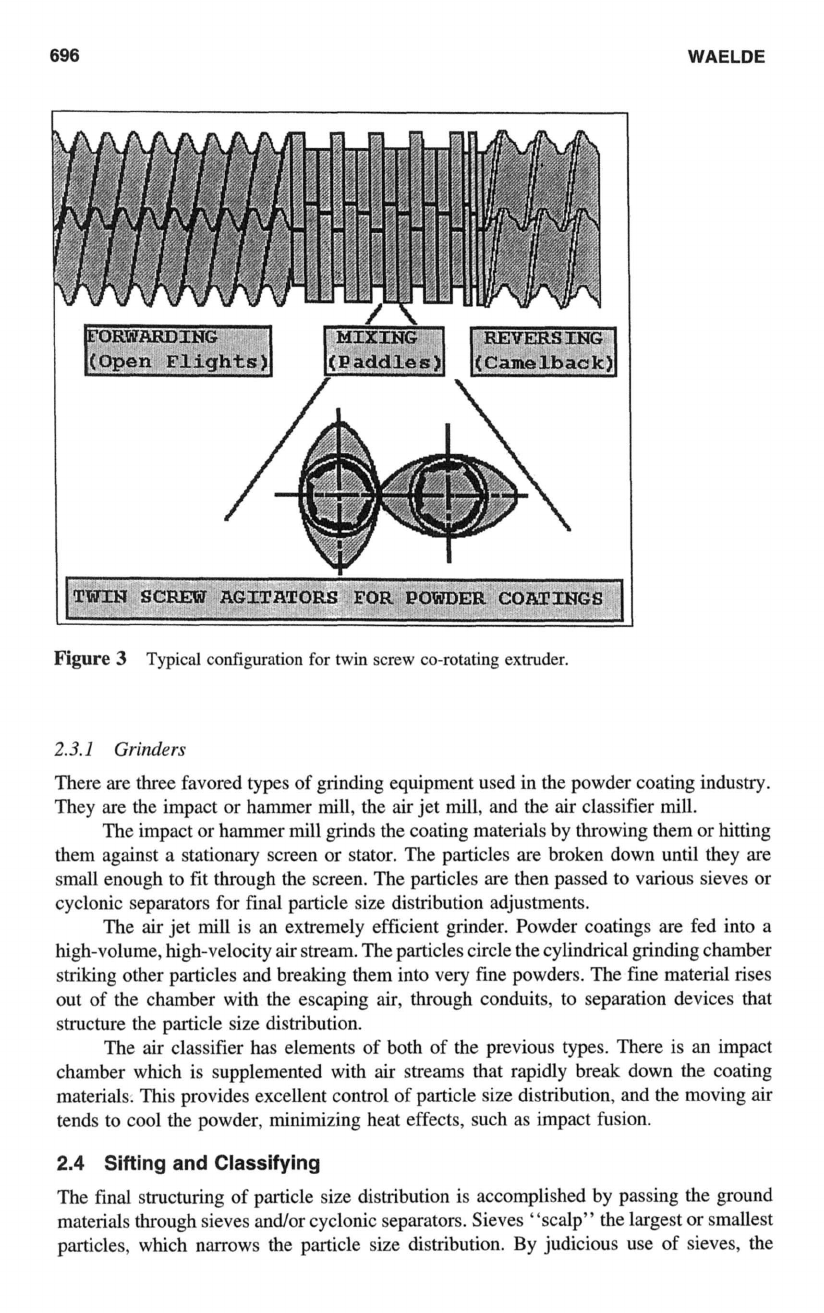
696
WAELDE
(Open
Flights
)
Figure
3
Typical
configuration
for
twin
screw co-rotating extruder.
2.3.
l
Grinders
There are three favored types of grinding equipment used in the powder coating industry.
They are the impact or hammer mill, the air jet mill, and the air classifier mill.
The impact or hammer
mill
grinds the coating materials by throwing them or hitting
them against a stationary screen or stator. The particles
are
broken down until they are
small enough to fit through the screen. The particles
are
then passed to various sieves or
cyclonic separators for final particle size distribution adjustments.
The air jet mill is an extremely efficient grinder. Powder coatings
are
fed into a
high-volume, high-velocity air stream. The particles circle the cylindrical grinding chamber
striking other particles and breaking them into very fine powders. The fine material rises
out of the chamber with the escaping air, through conduits, to separation devices that
structure the particle size distribution.
The air classifier has elements of both of the previous types. There is
an
impact
chamber which is supplemented with air streams that rapidly break down the coating
materials. This provides excellent control of particle size distribution, and the moving air
tends to cool the powder, minimizing heat effects, such as impact fusion.
2.4
Sifting and Classifying
The final structuring of particle size distribution is accomplished by passing the ground
materials through sieves
and/or
cyclonic separators. Sieves “scalp” the largest or smallest
particles, which narrows the particle size distribution. By judicious use of sieves, the
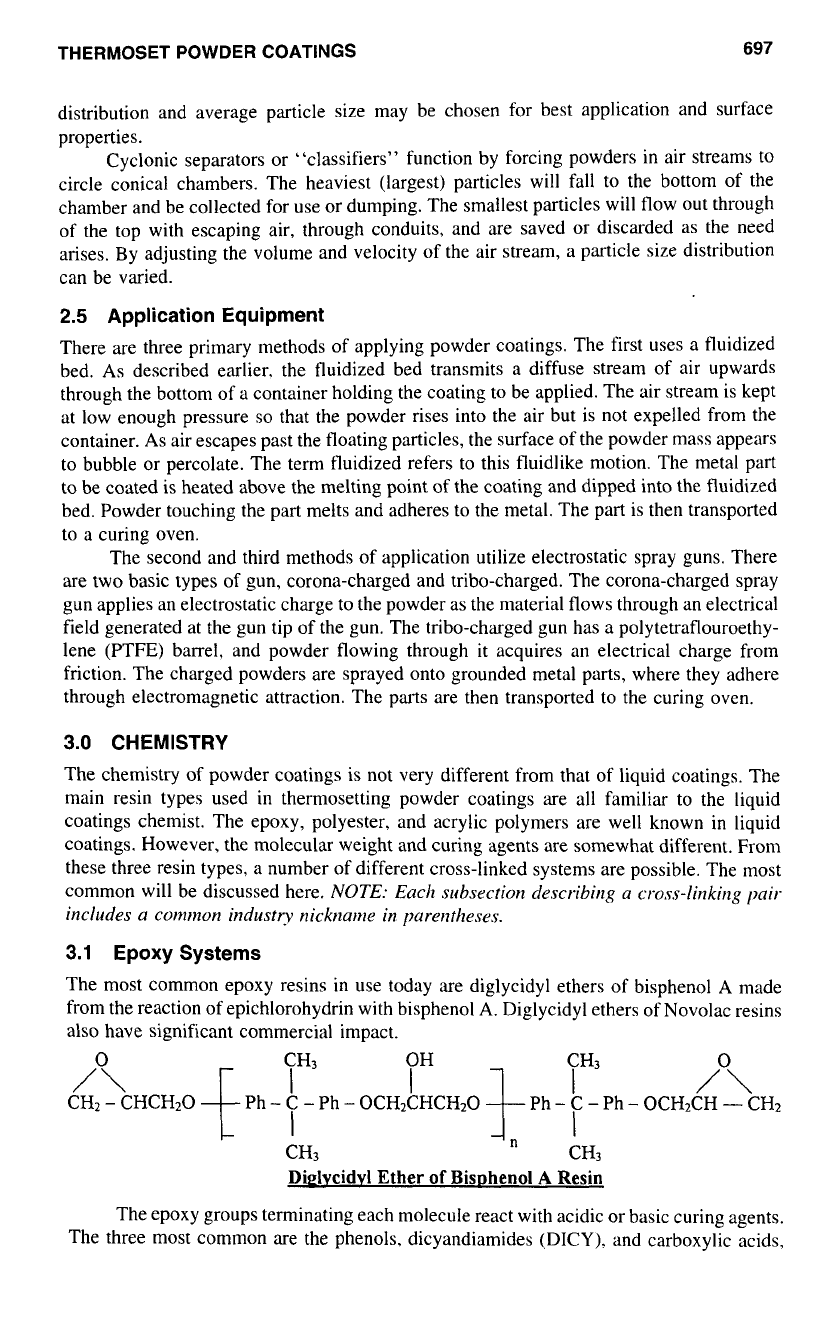
THERMOSET POWDER COATINGS
697
distribution and average particle size may be chosen for best application and surface
properties.
Cyclonic separators
or
“classifiers” function by forcing powders in air streams
to
circle conical chambers. The heaviest (largest) particles will fall
to
the bottom of the
chamber and be collected for use or dumping. The smallest particles will
flow
out through
of the top with escaping air, through conduits, and are saved
or
discarded
as
the need
arises. By adjusting the volume and velocity of the air stream,
a
particle size distribution
can be varied.
2.5
Application Equipment
There are three primary methods of applying powder coatings. The first uses
a
fluidized
bed.
As
described earlier. the fluidized bed transmits
a
diffuse stream
of
air upwards
through the bottom
of
a
container holding the coating to be applied. The air stream is kept
at low enough pressure
so
that the powder rises into the air but
is
not expelled from the
container.
As
air escapes past the floating particles, the surface of the powder mass appears
to
bubble or percolate. The term fluidized refers to this fluidlike motion. The metal part
to be coated is heated above the melting point
of
the coating and dipped into the fluidized
bed. Powder touching the part melts and adheres to the metal. The part is then transported
to
a
curing oven.
The second and third methods of application utilize electrostatic spray guns. There
are two basic types of gun, corona-charged and tribo-charged. The corona-charged spray
gun applies an electrostatic charge
to
the powder
as
the material flows through an electrical
field generated at the gun tip of the gun. The tribo-charged gun has a polytetraflouroethy-
lene (PTFE) barrel, and powder flowing through it acquires an electrical charge from
friction. The charged powders are sprayed onto grounded metal parts, where they adhere
through electromagnetic attraction. The parts are then transported to the curing oven.
3.0
CHEMISTRY
The chemistry
of
powder coatings is not very different from that of liquid coatings. The
main resin types used in thermosetting powder coatings are all familiar to the liquid
coatings chemist. The epoxy, polyester, and acrylic polymers are well known in liquid
coatings. However, the molecular weight and curing agents are somewhat different. From
these three resin types,
a
number of different cross-linked systems are possible. The most
common will be discussed here.
NOTE:
Each subsection describing a cross-linking pair
includes a comnon industry nicknarne in parentheses.
3.1
Epoxy Systems
The most common epoxy resins in use today are diglycidyl ethers
of
bisphenol
A
made
from the reaction of epichlorohydrin with bisphenol
A.
Diglycidyl ethers of Novolac resins
also
have significant commercial impact.
i
I
‘
-1,;
CH3 OH CH3
/”\
CH2
-
CHCH20
Ph
-
C
-
Ph
-
OCHzCHCHzO
Ph
-
C
-
Ph
-
OCHZCH
-
CH;!
CH3 CH3
Diglvcidvl
Ether
of
BisDhenol
A
Resin
The epoxy groups terminating each molecule react with acidic or basic curing agents.
The three most common are the phenols, dicyandiamides
(DICY).
and carboxylic acids.
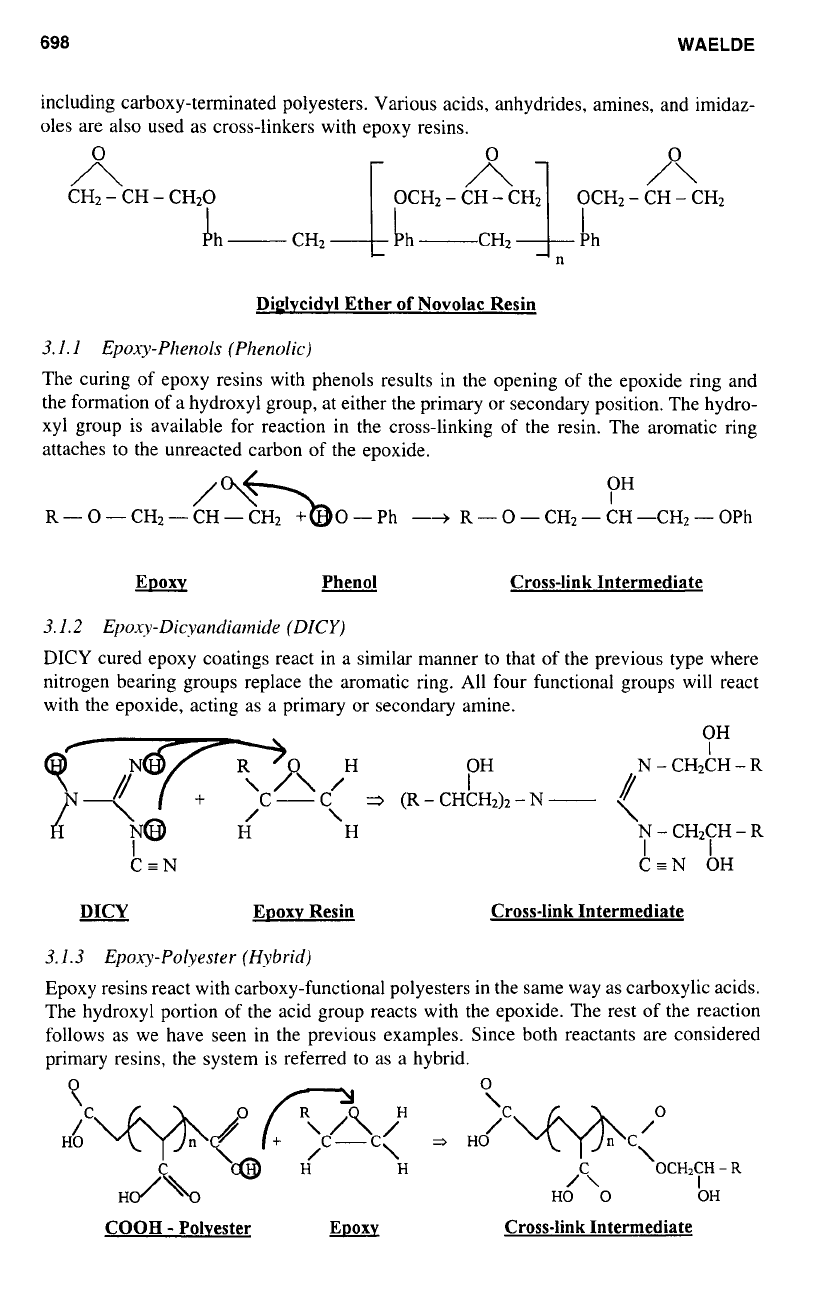
698
WAELDE
including carboxy-terminated polyesters. Various acids, anhydrides, amines, and imidaz-
oles are also used as cross-linkers with epoxy resins.
-
CH
-
CH~
Diglycidyl Ether
of
Novolac Resin
3.1.1
Epoxy-Phenols (Phenolic)
The curing
of
epoxy resins with phenols results in the opening of the epoxide ring and
the formation of a hydroxyl group, at either the primary or secondary position. The hydro-
xyl group is available for reaction in the cross-linking of the resin. The aromatic ring
attaches to the unreacted carbon of the epoxide.
OH
I
0-Ph
-+
R-O-CH2-CH-CH;?-OPh
EQOX~ Phenol Cross-link Intermediate
3.1.2
Epoxy-Dicyandiamide (DICY)
DICY
cured epoxy coatings react in a similar manner to that of the previous type where
nitrogen bearing groups replace the aromatic ring. All four functional groups will react
with the epoxide, acting as a primary or secondary amine.
OH
I
OH
I
+
C-
3
(R
-
CHCH2)2
-
N
-
/
\
H
H N
-
CH2CH
-
R
I
I
C=N C=N OH
DICY
EQOXY
Resin Cross-link Intermediate
3.1.3
Epoxy-Polyester (Hybrid)
Epoxy resins react with carboxy-functional polyesters in the same way as carboxylic acids.
The hydroxyl portion
of
the acid group reacts with the epoxide. The rest of the reaction
follows as we have seen in the previous examples. Since both reactants are considered
primary resins, the system is referred to
as
a
hybrid.
‘i
0
3
H0
/O
H0
\
nC
\
H
/c\
OCHlCH
-
R
H
H0
0
bH
COOH
-
Polyester Cross-link Intermediate
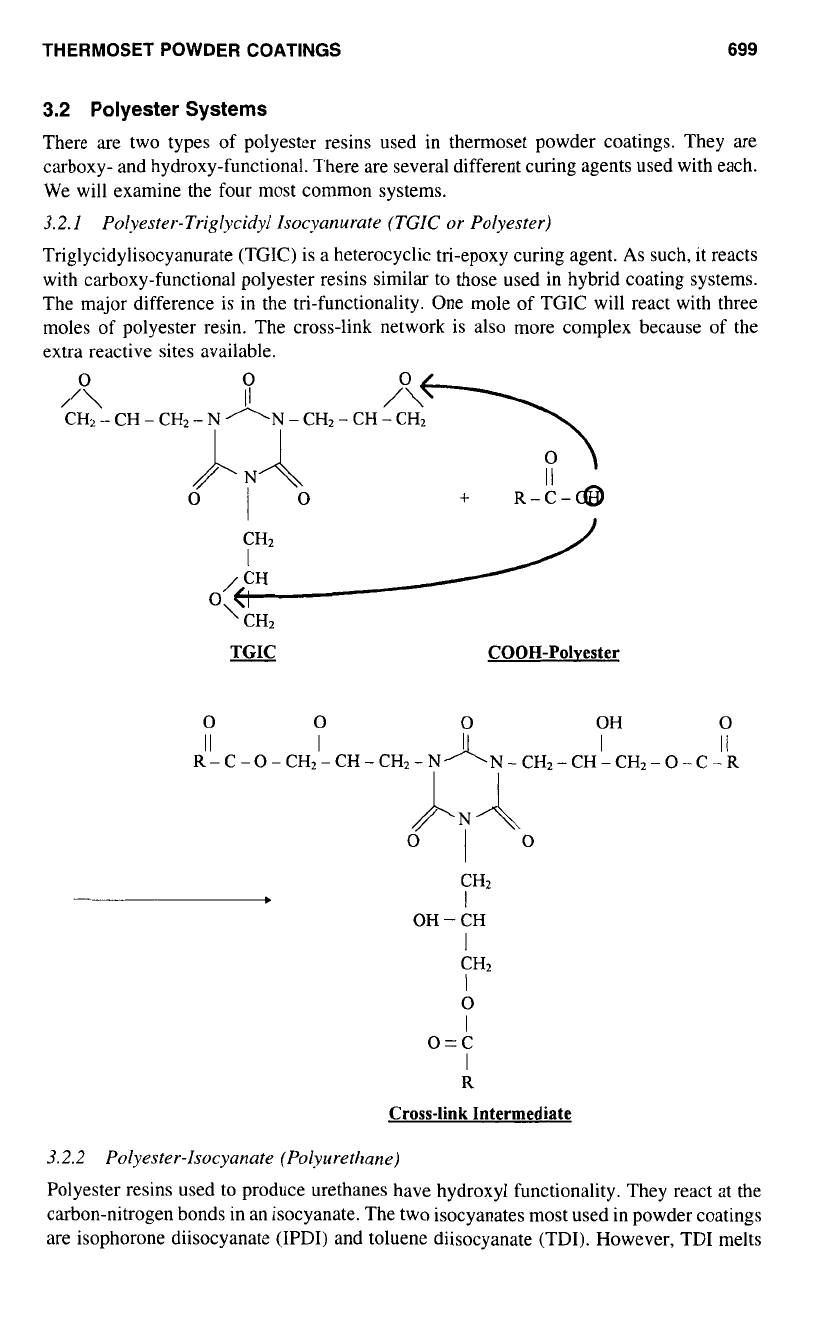
THERMOSET
POWDER
COATINGS
699
3.2
Polyester Systems
There are two types of polyester resins used in thermoset powder coatings. They are
carboxy- and hydroxy-functional. There are several different curing agents used with each.
We will examine the four most common systems.
3.2.1 Polyester-Triglycidyl Isocyanurutr
(TGIC
or Polyester)
Triglycidylisocyanurate (TGIC) is a heterocyclic tri-epoxy curing agent.
As
such, it reacts
with carboxy-functional polyester resins similar to those used in hybrid coating systems.
The major difference is in the tri-functionality. One mole of TGIC will react with three
moles
of
polyester resin. The cross-link network is also more complex because of the
extra reactive sites available.
0
CH2-CH-CH2-NnN-CH2-CH-CH2
I1
/”\?>
I1
+
R-C-@
‘
CH2
COOH-Polyester
0 0
0
OH
0
R-C-O-CH2-CH-CH2-NAN-CH~-CH-CH2-O-C-R
II
I I
I1
OI
O
AA
CH2
I
OH
-
CH
I
CH2
l
0
I
o=c
I
R
Cross-link Intermediate
3.2.2 Polyester-Isocyanate (Polyurethane)
Polyester resins used to produce urethanes have hydroxyl functionality. They react at the
carbon-nitrogen bonds in an isocyanate. The two isocyanates most used in powder coatings
are isophorone diisocyanate
(IPDI)
and toluene diisocyanate (TDI). However,
TDI
melts
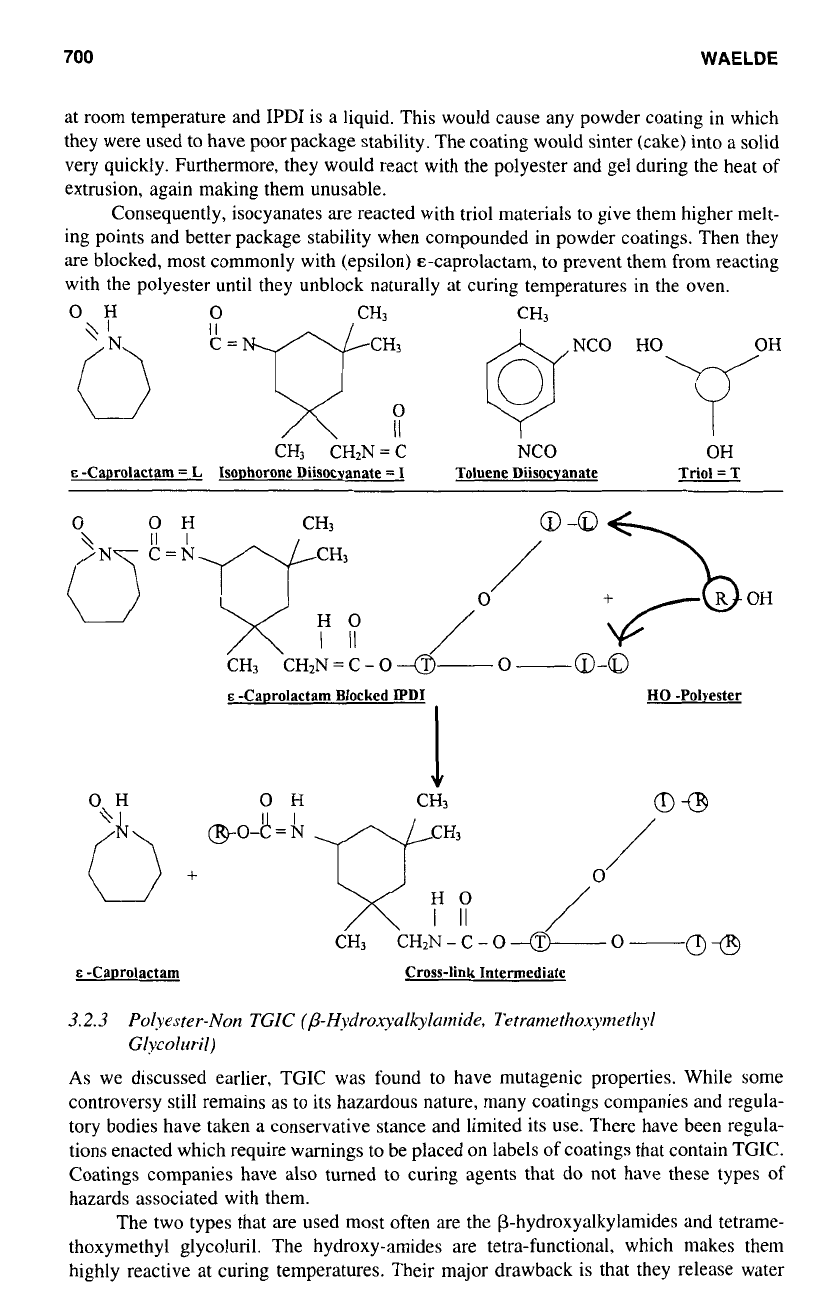
700
WAELDE
at room temperature and
IPDI
is a liquid. This would cause any powder coating in which
they were used to have poor package stability. The coating would sinter (cake) into a solid
very quickly. Furthermore, they would react with the polyester and gel during the heat
of
extrusion, again making them unusable.
Consequently, isocyanates are reacted with triol materials
to
give them higher melt-
ing points and better package stability when compounded in powder coatings. Then they
are blocked, most commonly with (epsilon) &-caprolactam, to prevent them from reacting
with the polyester until they unblock naturally at curing temperatures in the oven.
OH
6
:=g
0
CH3
;
@NCO CH3 HOTOH
E
-Caprolactam
=
L
Isoahorone Diisocvanate
=
I
Toluene Diisocvanate Triol
=
T
CH3 CHzN= C NCO OH
E
-Caprolactam Blocked
IPDI
l
H0
-Polvester
OH OH CH3
fi
+
@O-8
=h
H3
/""
7;
/O
CH3 CHzN-C-O~-O-~~
E
-CaDrolactam Cross-link Intermediate
3.2.3
Polyester-Non
TGIC
(P-Hydroxyalkylamide, Tetrametl~o~~nzetl~~l
Glyoluril)
As
we discussed earlier, TGIC was found
to
have mutagenic properties. While some
controversy still remains as to its hazardous nature, many coatings companies and regula-
tory bodies have taken a conservative stance and limited its use. There have been regula-
tions enacted which require warnings to be placed on labels of coatings that contain TGIC.
Coatings companies have also turned to curing agents that do not have these types
of
hazards associated with them.
The two types that are used most often are the P-hydroxyalkylamides and tetrame-
thoxymethyl glycoluril. The hydroxy-amides are tetra-functional, which makes them
highly reactive at curing temperatures. Their major drawback is that they release water
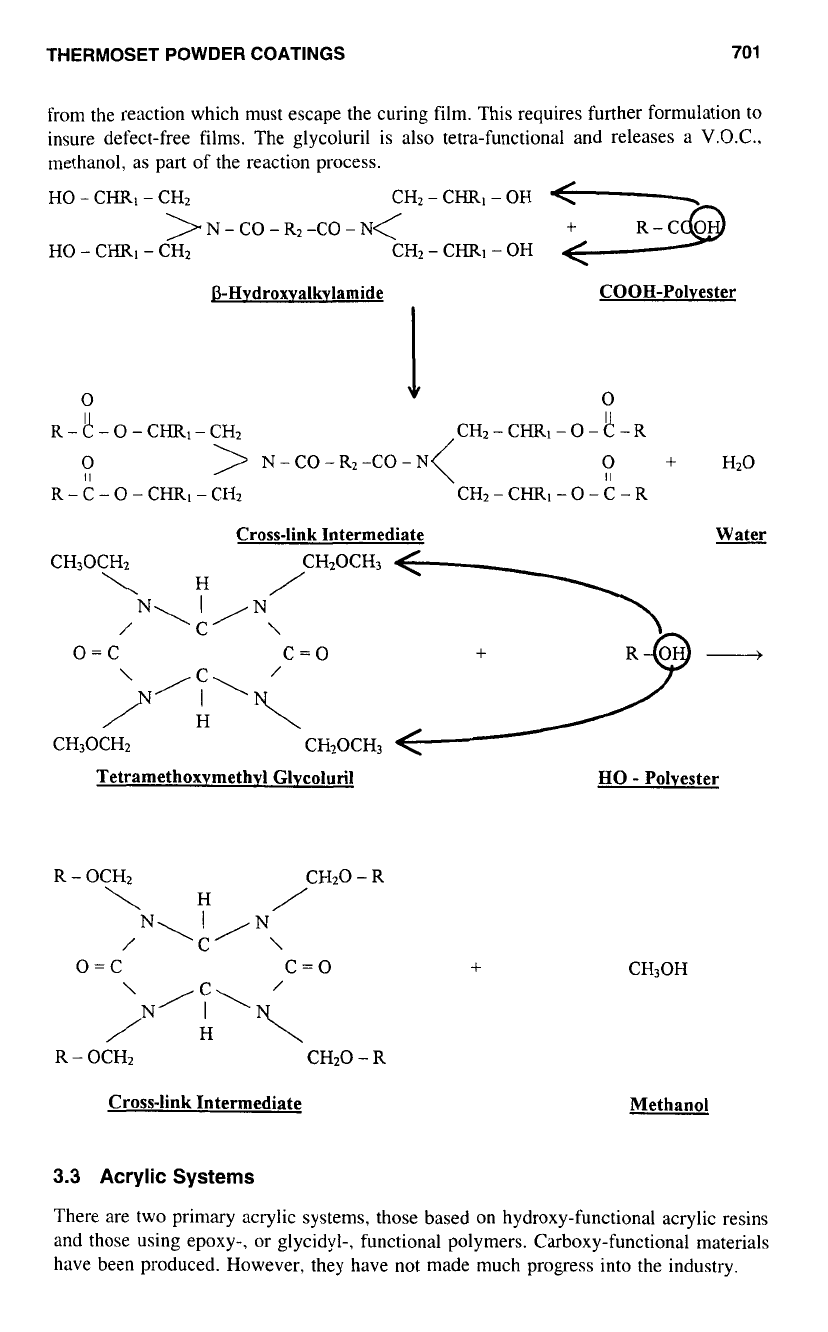
THERMOSET
POWDER
COATINGS
701
from the reaction which must escape the curing film. This requires further formulation
to
insure defect-free films. The glycoluril is also tetra-functional and releases a V.O.C..
methanol, as part of the reaction process.
H0
-
CHRI
-
CH2 CH2
-
CHRl
-
OH
>N-CO-R2-CO-N<
H0
-
CHRl
-
CH2 CH2
-
CHRl
-
OH
8-Hydroxyalkylamide
0
1
COOH-Polyester
0
R-t-O-CHR-CH2 <CH2-CHR-O-d-R
I
0
>
N-CO-R2-CO-N
0
II
+
H20
R-C-0-CHR-CH2 CH2-CHRl-0-C-R
II
Cross-link Intermediate Water
CH3OCH2
\H
/CH20CH3
/
"\L/\
o=c
c=o
CH3OCH2 CH20CH3
-4
Tetramethoxvmethyl Glvcoluril
H0
-
Polyester
R
-
OCH2
o=c c=o
\
/
/H
CH3OH
R
-
OCH2 CH20
-
R
Cross-link Intermediate Methanol
3.3
Acrylic Systems
There are two primary acrylic systems, those based
on
hydroxy-functional acrylic resins
and those using epoxy-, or glycidyl-, functional polymers. Carboxy-functional materials
have been produced. However, they have
not
made much progress into the industry.
